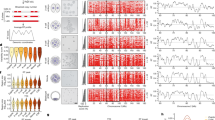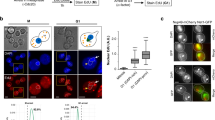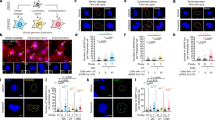Abstract
OVER the past few years increasing attention has been focused on the relationship of gene inactivation to the phenomena of interphase DNA condensation and late DNA replication. It has been shown that the sex chromatin body of female mammalian cells appears during early embryogenesis1 and is composed of one X chromosome2. In 1961 Lyon postulated that phenotypic variegation in heterozygotic female mice was a consequence of the inactivation of either the maternal or paternal X chromosome3. As well as being mostly metabolically inert, this X chromosome replicates late in the DNA synthetic period4,5. It has been assumed that the Y chromosome also becomes largely inactivated during early embryonic life, since it shows positive heteropyknosis in early prophase, is late replicating, and extra Y chromosomes produce no conspicuous phenotypic effects6. That late-replicating autosomal DNA may be related to gene inactivation is supported by the observation that the abnormal chromosome material found in most human autosomal chromosome abnormalities replicates toward the end of the DNA synthetic period. It was postulated that this late-replicating DNA is less deleterious than early replicating DNA when present in excess or deleted because it is relatively inert6. Furthermore, it has been shown that interphase heterochromatin is less active than euchromatin in that it produces less RNA7,8, and that late-replicating chromosomes have less capacity for RNA synthesis9.
This is a preview of subscription content, access via your institution
Access options
Subscribe to this journal
Receive 51 print issues and online access
$199.00 per year
only $3.90 per issue
Buy this article
- Purchase on Springer Link
- Instant access to full article PDF
Prices may be subject to local taxes which are calculated during checkout
Similar content being viewed by others
References
Park, W. W., J. Anatomy, 91, 369 (1957).
Ohno, S., Kaplan, W. O., and Kinosita, R., Exp. Cell Res., 18, 415 (1959).
Lyon, M. E., Nature, 190, 372 (1961).
Taylor, J. H., J. Biophys. Biochem. Cytol., 7, 455 (1960).
Morishima, A., Grumbach, M. M., and Taylor, J. H., Proc. U.S. Nat. Acad. Sci., 48, 756 (1962).
Yunis, J. J., Nature, 205, 311 (1965).
Frenster, J. H., Allfrey, V. G., and Mirsky, A. E., Proc. U.S. Nat. Acad. Sci., 50, 1026 (1963).
Hsu, T. C., Exp. Cell Res., 27, 332 (1962).
Klevecz, R. R., and Hsu, T. C., Proc. U.S. Nat. Acad. Sci., 51, 1282 (1964).
Ford, C. E., and Hamerton, J. L., Stain Tech., 31, 247 (1956).
Fredga, K., Hereditas, 51, 268 (1964).
Kopriwa, B. M., and Leblond, C. P., J. Histochem. Cytochem., 10, 269 (1962).
Hsu, T. C., and Zenses, M. T., J. Nat. Cancer Inst., 32, 857 (1964).
Hsu, T. C., J. Cell Biol., 23, 53 (1964).
Author information
Authors and Affiliations
Rights and permissions
About this article
Cite this article
PFLUEGER, O., YUNIS, J. Deoxyribonucleic Acid Replication of Somatic Cells in the Chinese Hamster. Nature 210, 1074–1075 (1966). https://doi.org/10.1038/2101074a0
Issue Date:
DOI: https://doi.org/10.1038/2101074a0
This article is cited by
-
Autoradiographic studies of human chromosomes
Chromosoma (1971)
-
Autoradiographische Untersuchungen mit 3H-Thymidin an der regenerierenden Rattenleber
Zeitschrift f�r Zellforschung und Mikroskopische Anatomie (1967)
Comments
By submitting a comment you agree to abide by our Terms and Community Guidelines. If you find something abusive or that does not comply with our terms or guidelines please flag it as inappropriate.



